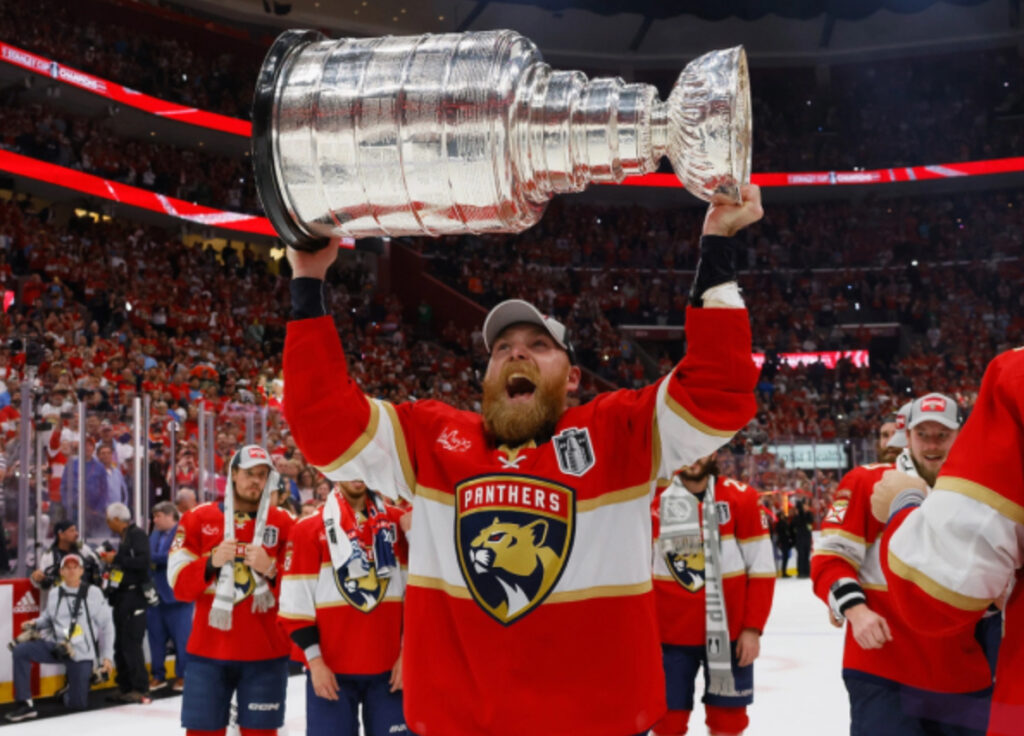As the Florida Panthers charge into the Stanley Cup Final once again, one question looms over the celebration: Is the lack of a state income tax giving them a hidden edge?
This marks the sixth consecutive year that a team from a no-income-tax state has reached the NHL’s grandest stage. It’s no longer a coincidence. It’s a trend. And in a league governed by a strict salary cap, where every dollar counts, location may be becoming one of the most powerful recruiting tools in professional hockey.
In the NFL, NBA, and MLB, the impact of tax policy has been debated for years. But in the NHL—where salary caps and escrow already eat into player earnings—the math is even more unforgiving. So when a franchise like the Panthers or the Dallas Stars can offer a contract worth the same on paper but significantly more in take-home pay, that’s not just attractive. It’s decisive.
Welcome to hockey’s version of tax arbitrage.
Florida Rising: The Panthers’ Power Play in the Front Office
When the Florida Panthers lifted the Prince of Wales Trophy last year and stormed into the Stanley Cup Final, it was easy to chalk it up to a Cinderella run. But now, after consecutive deep playoff pushes and a roster brimming with top-tier talent, it’s time to acknowledge the reality: the Panthers have become a destination franchise.
Yes, that’s right—Florida, a place once mocked for poor attendance and nontraditional fan culture, now boasts one of the deepest rosters in hockey. And it’s not just homegrown. It’s filled with smart acquisitions, trades, and most notably, free agent signings.
When big names hit the market, the Panthers are suddenly in the conversation. Why? Because Florida has no state income tax, meaning players can pocket significantly more of their contracts than they could in, say, California or New York.
Let’s be blunt: If you’re a player deciding between $9 million a year in San Jose or $9 million in Sunrise, Florida—the choice isn’t just about climate or winning potential. It’s about taking home millions more over the life of the deal.
The Salary Cap and the Salary Gap
The NHL salary cap was introduced in 2005 to create parity. It worked—for a while. The idea was simple: cap the maximum each team can spend, and eliminate financial inequality between large and small markets.
But the cap is agnostic to taxes. It doesn’t account for how much money players actually get to keep. So while teams can only offer a set amount on paper, the real-world value of those contracts varies wildly depending on geography.
In Florida, Texas, Nevada, Tennessee, and Washington—states without income tax—players don’t pay a dime of their salary to the state. In California, they can pay over 13%. That’s a massive delta.
To match a $9 million offer from a tax-free team, a high-tax state might need to offer $10.2 million or more just to keep the take-home pay equal. But with a hard cap in place, they can’t. That creates a built-in competitive disadvantage.
Mikko Rantanen and the Texas Temptation
Earlier this year, Mikko Rantanen—already one of the NHL’s most productive forwards—signed a massive 8-year, $96 million extension with the Dallas Stars. What made headlines wasn’t just the deal itself, but the context.
Rantanen was traded mid-season, first from Colorado to Carolina, then from Carolina to Dallas. Carolina reportedly offered a richer deal than Dallas—but Rantanen chose Texas.
Why?
It wasn’t just about cup contention (though Dallas is undoubtedly stacked). Reports indicated Rantanen took less up front because the net income in Texas would still land him ahead. The math was irrefutable. Eight years in a no-tax state is a golden ticket.
This isn’t just speculation—it’s becoming common practice. Agents are factoring in tax jurisdictions in negotiations. Players are asking for “tax-adjusted” comparables. And teams in low-tax states are weaponizing this advantage.
The Snowball Effect: Winning, Taxes, and Momentum
The relationship between taxes and team success isn’t just theoretical. Let’s look at recent Stanley Cup Finalists:
- 2024: Florida Panthers (Florida – no income tax)
- 2023: Vegas Golden Knights (Nevada – no income tax)
- 2022: Tampa Bay Lightning (Florida – no income tax)
- 2021: Dallas Stars (Texas – no income tax)
- 2020: Tampa Bay Lightning again
That’s not coincidence. That’s a pattern. Teams in tax-friendly states are consistently competing at the highest level. And once a team becomes competitive, it’s easier to lure more talent—creating a feedback loop of success.
This doesn’t mean teams in high-tax states can’t compete. The Colorado Avalanche, Boston Bruins, and New York Rangers are all elite. But they’re often forced to overpay, rely more on internal development, or take creative risks to compensate for the tax gap.
Meanwhile, a team like Tampa Bay can pitch top players not only on a chance to win—but on the fact that a $6 million contract there might be worth $1 million more per year in actual take-home pay than the same deal in Toronto or Montreal.
That’s a difference agents can’t ignore.
The Human Side: More Than Just Money
While it’s easy to reduce decisions to dollars, tax savings aren’t the only reason players are moving to places like Florida, Texas, or Nevada.
Lifestyle matters. Warm weather, favorable travel schedules, and franchise stability all play a role. But they’re intertwined.
Florida teams, for instance, are now able to reinvest the savings they generate into better facilities, coaching staff, and player support systems. Tax advantages don’t just land star signings—they help build an organizational culture of winning.
Plus, in an era where athletes are increasingly attuned to financial planning, wealth preservation, and long-term security, location-based benefits are part of the personal calculus.
A player who signs a $56 million deal in Florida might retire with $5–7 million more in the bank than a peer who signs in California for the same number. That’s not a marginal benefit—that’s life-changing.
Are Tax-Friendly Teams Breaking the Spirit of the Cap?
This brings us to the ethical and structural heart of the debate.
Is this trend undermining the NHL’s hard cap? If the cap is supposed to create financial parity, but tax codes create effective salary disparities, then the playing field isn’t level.
It’s not cheating. It’s not manipulation. It’s reality.
But for franchises in high-tax states, it’s frustrating. They are doing everything by the book, only to lose talent to sunnier locales that offer functionally higher contracts under the same cap.
This has triggered calls—from fans, executives, and media—for some sort of tax-equalization mechanism in the NHL’s next collective bargaining agreement (CBA).
Ideas floated include:
- Tax-adjusted salary caps for each team
- League-subsidized equalization funds
- Luxury tax systems to replace the hard cap
So far, nothing has gained traction. But if the trend continues—and if Florida, Vegas, or Dallas wins another Cup—the chorus will grow louder.
The Canadian Conundrum
No discussion on this topic is complete without touching on the plight of Canadian teams.
Not only do they face some of the highest income tax rates in the league, but their players also deal with currency fluctuations, political scrutiny, and relentless media pressure. It’s no wonder top-tier free agents often bypass markets like Ottawa, Winnipeg, or Calgary.
This has created an imbalance in a sport that was born in Canada. A country that contributed so much to hockey’s DNA is now at a structural disadvantage due to policies outside the sport’s control.
To many in Canada, it feels like an unfair fight. And unless the league steps in to address the disparity, it may only get worse.
What’s Next? The CBA and the Future of Fairness
The NHL’s current collective bargaining agreement runs through 2026. Between now and then, expect serious debate over how tax codes intersect with league parity.
Players’ unions, owners, and GMs will need to grapple with uncomfortable questions:
- Should geography dictate competitiveness?
- Should player earnings be equalized by the league?
- Is the hard cap sustainable in a world with growing financial gaps?
The NHL has always prized parity. Its playoff structure is built around unpredictability. But if tax policy becomes a cheat code, the league may need to adapt or risk watching the same handful of teams dominate year after year.
Flow
Hockey has always been a game of inches. Small decisions—line changes, faceoffs, rebounds—can swing the outcome. Off the ice, it’s no different. Marginal advantages—like climate, coaching, or yes, income tax—can be the difference between hoisting the Cup and heading home.
The Florida Panthers didn’t get to the Stanley Cup Final just because of taxes. They have smart management, a hungry roster, and elite coaching. But their financial edge helped them build and maintain that foundation.
As more players prioritize take-home pay, and as more teams build dynasties from tax havens, the rest of the league faces a choice: adapt or fall behind.
The puck has dropped on a new era of roster building. And this time, the numbers off the ice may matter just as much as the ones on the scoreboard.
No comments yet.








